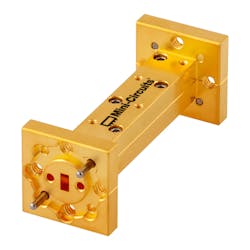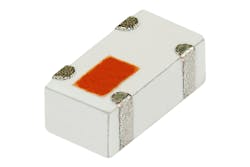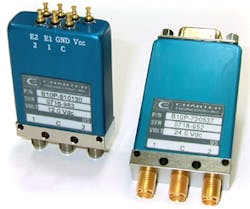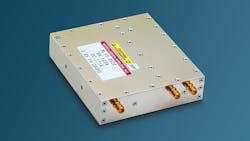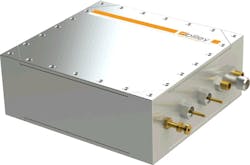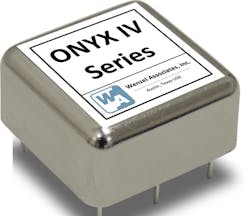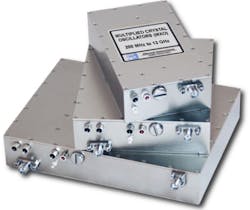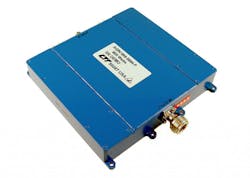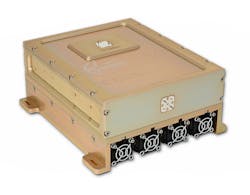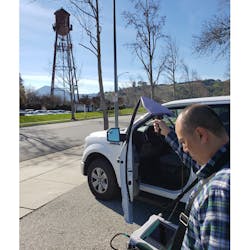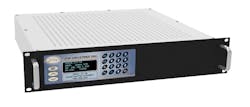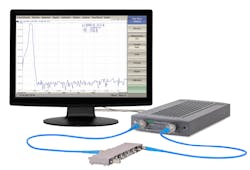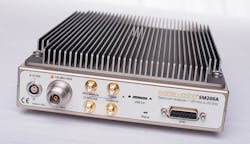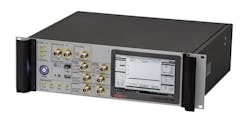The 2019 IMS Exhibition Brings High Expectations
Download this article in PDF format.
In a year in which the RF/microwave industry is besieged with heightening demand for high-frequency technology different markets spanning everything from commercial to military, the 2019 IEEE International Microwave Symposium (IMS) will descend on one of the traditional centers of innovation and engineering: Boston, Massachusetts. With the ever-increasing numbers of applications for high-frequency electronics, this year’s show promises to be one of the all-time best-attended IMS conferences and exhibitions.
Scheduled for the Boston Convention and Exhibition Center from June 2-7, 2019, the exhibition floor will host over 600 companies, offering an impressive cross-section of the many markets and technical segments of the RF/microwave industry. While any visitor would be hard-pressed to visit every exhibition booth at the 2019 IMS, time spent with any of the exhibitors will not be wasted. What follows is a brief summary of some of exhibitors and the products expected to be on display.
Whether it’s for comparing passive components, active components, integrated circuits (ICs), software, or test-and-measurement equipment, visitors to the 2019 IMS will have an opportunity to “go shopping” for some of the latest technologies in the industry, from an array of the industry’s best-known suppliers. With only three days, of course, the exhibition time passes quickly with each stop at each exhibition booth, making it difficult to cover a lot of ground on a crowded exhibition floor. Visitors are advised to save datasheets and brochures from each stop for future reference.
Attendees intrigued by what the Fifth Generation (5G) of cellular wireless communications will mean to business and personal lifestyles can receive a quick education with one stop, at the 5G Exhibition Pavilion (booth 2000). This single-booth location offers visitors a chance to meet with representatives from a half-dozen companies involved in 5G systems: Mixcomm, Memtronics, NanoSemi, Pentek, SynMatrix, and Silicon Solutions.
Memtronics will show where microelectromechanical-systems (MEMS) technology fits into a 5G future with a sampling of some of its components, including RF/microwave switches, phase shifters, and tunable filters. The technology can reach well into the millimeter-wave (mmWave) frequency range to serve applications in both commercial and military systems. Although MEMS components sacrifice a bit in switching speed over purely electronic components, the combination of mechanical and electronic functions in switches and other components is extremely reliable, with outstanding linearity compared to electronic components.
NanoSemi will share how it applies its digital signal compensation to analog radio designs to correct for nonlinear effects. Visitors to the 5G Exhibition Pavilion can also learn more about the specialized mmWave technology developed by Mixcomm from its founders Dr. Harish Krishnaswamy and Dr. Ashwin Sampath. Pentek will show some of its compact board-level solutions for digital signal processing and recording for commercial and military systems, including the latest member of the Jade family of high-performance 3U VPX modules, the model 54851. With RF and optical interconnections, it’s built around a high-speed field-programmable gate array (FPGA) and several high-resolution analog-to-digital converters.
SynMatrix will dive into its cloud-based computer-aided-engineering (CAE) tools for speeding and automating the RF/microwave component design process. Usable from almost any computer with access to the internet, these software tools allow such functions as filter design and tuning, circuit analysis, and even thermal analysis of high-power designs. Silicon Solutions will also welcome visitors with news about its semiconductor-based solutions for 5G.
Known to have one of the industry’s widest assortments of active and passive components, Mini-Circuits (Booth 330) will bring an extensive sampling of its product lines, including the ZVBP Series of cavity bandpass filters (Fig. 1) with passbands to 15 GHz and stopbands to 20 GHz. As an example, model ZVBP-10R5G+ is a cavity bandpass filter with a passband from 9750 to 11250 MHz and stopband to 18 GHz. Insertion loss is typically 0.5 dB across the passband with a low VSWR of typically 1.30:1. The rejection across the lower stopband of dc to 5950 MHz is typically 51 dB, while the rejection for the upper stopband of 15.1 to 18.0 GHz is typically 45 dB. The filters are equipped with female SMA connectors and designed for operating temperatures from −40 to +85°C. They measure only 1.65 × 0.79 × 0.75 in. (41.92 × 20.00 × 19.00 mm) and handle input power levels to 1 W.
1. The ZVBP Series of compact cavity bandpass filters covers passbands to 15 GHz and stopbands to 20 GHz. (Courtesy of Mini-Circuits)
For compact filters at mmWave frequencies, such as for 5G and 77-GHz automotive radar testing, Mini-Circuits’ WVBP Series of waveguide bandpass filters (Fig. 2) were developed in partnership with Virginia Diodes and cover frequency bands from 27 to 86 GHz. Equipped with standard rectangular-waveguide (WR) interfaces, these filters have low passband insertion loss and high stopband rejection to suppress unwanted signals. The RoHS-compliant filters are designed for operating temperatures from −40 to +85°C.
2. The WVBP Series of waveguide bandpass filters, developed jointly with Virginia Diodes, covers frequency bands from 27 to 86 GHz. (Courtesy of Mini-Circuits)
As an example, model WVBP-283-WR28+ has a center frequency of 28 GHz with a passband of 27.50 to 28.35 GHz. The lower stopband is 22 to 27 GHz and the upper stopband is 28.85 to 38.00 GHz. Passband insertion loss is typically 0.5 dB and passband return loss is typically 18 dB. The lower stopband rejection is 65 dB at 22 GHz and 30 dB at 27 GHz, while the upper stopband rejection is 39 dB at 28.85 GHz and 31 dB at 38 GHz. The filter includes a WR28 waveguide interface.
Mini-Circuits will also show a new line of LTCC baluns optimized for Wi-Fi, Bluetooth, and Zigbee wireless applications (Fig. 3), including the BLIC, BLGE, and BLNK Series RF transformers and dc blocks. As an example, model BLGE1-252R+ is a 50-Ω LTCC balun RF transformer with 1:1 impedance ratio from 2.4 to 2.5 GHz. It measures just 0.079 × 0.049 × 0.037 in. (2.00 × 1.25 × 0.95 mm) but handles 3 W power at room temperature (+25°C). The RoHS-compliant transformer exhibits low phase unbalance of typically 5 deg. and low amplitude unbalance of typically 0.2 dB. It’s designed for operating temperatures from −40 to +85°C, and is just one of many different components to be found at Mini-Circuits’ exhibit booth.
3. A line of LTCC balun RF transformers has been optimized for wireless applications. (Courtesy of Mini-Circuits)
Charter Engineering (Booth 660) will be at the 2019 IMS exhibition with some of its latest RF/microwave switches, including low passive-intermodulation (PIM) models and switches ready for 5G applications from dc to 40 GHz. High-frequency switches (Fig. 4) include miniature failsafe single-pole, double-throw (SPDT) switches with SMA female connectors for use from dc to 26.5 GHz in the B1 series and miniature failsafe latching SPDT switches with female SMA connectors in the B10 series for applications from dc to 26.5 GHz.
4. A broad family of RF/microwave switches from dc to 40 GHz includes models with low PIM. (Courtesy of Charter Engineering)
Weinschel Associates (Booth 372) will show it precision components, including dc blocks, power dividers, terminations, and fixed and variable attenuators such as the model VA04 continuously variable attenuator for use from dc to 4 GHz. Available with an attenuation range of 30, 60, or 90 dB, the continuously variable attenuation is a good match for research and testing applications. It handles 5 W average power and as much as 500 W peak power for a 5-µs pulse at a 0.5% duty cycle. The bidirectional variable attenuator is equipped with female SMA female input and output connectors.
Coming off the cover story in the April issue of Microwaves & RF, Krytar (Booth 825) will be providing application suggestions on the use of its 100-GHz-bandwidth model 1100110010 directional coupler. Using 1.90-mm female coaxial connectors, the 10-dB coupler covers a frequency range of 10 to 110 GHz. The mainline insertion loss is only 5.5 dB across the full bandwidth, while the maximum VSWR is 2.50:1. The directional coupler is rated for maximum CW power of 20 W and peak power of 3 kW for pulse widths as wide as 100 µs.
Generating Signals
Active and passive components are the building blocks for larger, more complex systems, and the IMS exhibition offers a virtual “real-time catalog” of these components in all shapes and sizes, from tiny chips to rack-mount enclosures, and from tiny integrated-circuit (IC) amplifiers to old-school tunable YIG oscillators. Among the many component manufacturers exhibiting at the 2019 IEEE IMS are several signal source suppliers, including clock oscillators, fixed and tunable RF/microwave oscillators, and frequency synthesizers for commercial, industrial, and military applications.
For example, Synergy Microwave Corp. (Booth 750) will highlight some of its many high-performance RF/microwave components, including frequency mixers, frequency synthesizers, and voltage-controlled oscillators (VCOs). One of the VCOs, model DCM02260-5, is a wideband unit with a tuning range of 220 to 600 MHz when fed tuning voltages of 0.5 to 24 V. The VCO, housed in a miniature surface-mount package, draws maximum current of 35 mA at +5 Vdc and provides at least +2 dBm output power across an operating temperature range of −40 to +85°C. The SSB phase noise is −108 dBc/Hz offset 10 kHz from the carrier, with typical harmonic suppression of 10 dB. The surface-mount VCO, with typical tuning sensitivity of 15 to 25 MHz/V, exhibits frequency pushing of typically 2 MHz/V and frequency pulling of typically 5 MHz into a 1.75:1 VSWR load.
At higher frequencies, Synergy will also have its model FSW85150-50 intelligent interactive frequency synthesizer for applications from 850 to 1500 MHz. Based on Synergy’s patented REL-PRO technology, the extremely compact, RoHS-compliant frequency synthesizer is supplied in a miniature surface-mount package (Fig. 5). It tunes in 500-kHz steps and settles to a new frequency of 5 ms or less. It’s designed for use with a 10-MHz frequency reference and provides +4 dBm output power by means of a buffered 50-Ω output port. The high-frequency source achieves 85-dB typical spurious suppression and 20-dB typical harmonic suppression. It exhibits typical phase noise of −90 dBc/Hz offset 1 kHz from the carrier, −93 dBc/Hz offset 10 kHz, and −120 dBc/Hz offset 100 kHz. It includes a 3.3-V CMOS lock-detect indicator and is designed for operating temperatures from −40 to +85°C.
5. Model FSW85150-50 is an intelligent interactive frequency synthesizer for use from 850 to 1500 MHz. (Courtesy of Synergy Microwave Corp.)
Of course, Synergy will have a great deal of company at the 2019 IMS in terms of oscillator and frequency-synthesizer suppliers, with many different source technologies represented. Micro Lambda Wireless (Booth 1104) will present a sampling of its extensive lines of YIG-tuned oscillators and low-noise frequency synthesizers, with wide tuning ranges and frequency coverage from 0.5 to 40.0 GHz. Oscillators come in miniature surface-mount-technology (SMT) packages, 1- and 1.24-in. cubes, 2-in.-diameter cylinders, and metal packages with coaxial connectors. For visitors in search of low phase noise at microwave and mmWave frequencies, these YIG oscillators can meet or beat the lowest noise levels available, with the ruggedness required for military applications.
The firm will also show some of its high-performance frequency synthesizers based on those YIG oscillators, for applications from 250 MHz to 33 GHz. For example, the MLMS-Series frequency synthesizers, capable of fitting into a single-slot PXI module, include models to 16 GHz with frequency tuning of 1 kHz. While current-tuned YIG oscillators offer outstanding phase noise, they lack tuning speed compared to other oscillator formats.
For applications requiring fast tuning speed, the MLVS-Series “LUXYN” frequency synthesizers are based on voltage-controlled oscillators (VCOs) rather than YIGs (Fig. 6). They cover frequency ranges of 50 MHz to 10 GHz ad 50 MHz to 21 GHz with 50-µs tuning speed and phase noise of only −125 dBc/Hz offset 10 kHz from a 10-GHz carrier. They are well-suited for wideband receivers and test equipment.
6. The MLVS-Series LUXYN frequency synthesizer provides low-noise figures from 50 MHz to 21 GHz. (Courtesy of Micro Lambda Wireless)
Z-Communications (Booth 155) will present some of its many high-frequency signal sources, including fixed-frequency and tunable oscillators. For example, model SFS9280C-LF is a phase-locked oscillator (PLO) designed to produce a fixed-frequency output signal at 9280 MHz when operating with a 10-MHz reference oscillator. The PLO achieves phase noise of −80 dBc/Hz offset 1 kHz from the carrier, −100 dBc/Hz offset 10 kHz from the carrier, and −120 dBc/Hz offset 100 kHz from the carrier. It delivers 0-dBm output power while drawing 90 mA from a +5-Vdc supply and 11 mA from a +3-Vdc phase-locked-loop supply. The harmonic suppression is typically −30 dBc while spurious suppression is −65 dBc. The PLO comes in a compact housing measuring just 1.0 × 1.0 × 0.22 in. With an operating temperature range of −40 to +85°C, the PLO is a good fit for satellite-communications (satcom) applications.
The company should also have its model CRO4187E-LF RoHS-compliant VCO on display. With a frequency range of 4187 to 4188 MHz, the VCO is also a match for satcom systems and test-and-measurement equipment. It fits in a SMT package measuring 0.5 × 0.5 × 0.22 in. and draws 30 mA current from a +8-Vdc supply. It delivers +3.5 dBm output power into a 50-Ω load over temperatures from −40 to +85°C. Phase noise is −108 dBc/Hz offset 10 kHz from the carrier.
Bliley Technologies (Booth 252) will show its wide assortment of crystal oscillators, from temperature-compensated crystal oscillators (TCXOs) and oven-controlled crystal oscillators (OCXOs) to its advanced gravitation (g) compensated oscillators for satellite and space applications. For example, the Poseidon 2 low-g compensated OCXO (Fig. 7) is designed for high-vibration environments where dynamic phase-noise performance is critical. These OCXOs are built for much improved acceleration sensitivity over standard oscillators, with performance of 0.02 ppb/g. Available with fixed frequencies between 5 and 130 MHz, the OCXOs feature −130 dBc/Hz phase noise offset 10 Hz from the carrier with an almost unnoticeable aging rate of ±0.25 ppm for 20 years.
7. This low-g-compensated OCXO is available for fixed frequencies from 5 to 130 MHz. (Courtesy of Bliley Technologies)
Drive by Clock
CTS Corp. (Booth 312) will have some of its latest clock oscillators on display at 2019 IMS, with some tailored for the growing automotive electronics markets. Typical clock frequencies include 12, 20, 25, 40, 50, and 125 MHz. The clock oscillators feature wide operating temperature ranges of −40 to +125°C for automotive, industrial, and commercial applications and −55 to +125°C for military and aerospace applications.
The CA Series oscillators are manufactured on TS16949-certified production lines and are AEC-Q200 qualified and PPAP-compliant for automotive, commercial, medical, and test-and-measurement applications, while the CHT Series oscillators are more aimed at military and aerospace applications over the wider temperature range. The oscillators are supplied in compact hermetic surface-mount packages. Each model delivers a CMOS output with typical rise/fall time of 5 ns. Frequency stability is as good as ±100 ppm for the CHT Series across the −55 to +125°C temperature range and ±25 ppm for the CA Series across the −40 to +85°C temperature range.
With its extensive lines of crystal oscillators (XOs) and oven-controlled crystal oscillators (OCXOs), Wenzel Associates (Booth 680) will be exhibiting numerous stable frequency reference sources. The firm’s ONYX Series XOs (Fig. 8) provide low-noise fixed-frequency outputs from 10 to 160 MHz in many different mechanical configurations.
8. The ONYX Series crystal oscillators (XOs) offer fixed-frequency outputs from 10 to 160 MHz. (Courtesy of Wenzel Associates)
For example, models 501-22578e-01 through 501-22578e-06 are 10-MHz XOs well-suited for addition to PCBs with their through-hole mounting. Featuring low-g sensitivity and low phase noise, the oscillators are supplied in nickel-plated steel packages measuring just 1.0 × 1.0 × 0.5 in. They provide +10 dBm output power with ±2-dB output power flatness into a 50-Ω load. The SSB phase noise for the -01, -02, and -03 versions is −125 dBc/Hz offset 10 Hz from the carrier, −160 dBc/Hz offset 1 kHz from the carrier, and −165 dBc/Hz offset 100 kHz from the 10-MHz carrier. Phase noise for the -04, -05, and -06 versions is −135 dBc/Hz offset 10 Hz from the carrier, −163 dBc/Hz offset 1 kHz from the carrier, and −165 dBc/Hz offset 100 kHz from the 10-MHz carrier. The aging rates for all units are ±5 × 10-10/day after 30 days and ±5 × 10-8/year after 180 days. The ONYX oscillators are equipped with an internal voltage regulator and have an option for a TTL-compatible output.
At higher frequencies, the MXO families of multiplied crystal oscillators (Fig. 9) can be customized to fixed-frequency outputs from 200 MHz to 12 GHz. The multiplied sources incorporate an XO with integrated frequency multipliers, amplifiers, and filters supplied in a nickel-plated machined aluminum case to handle the most demanding environmental conditions. SMA connectors and solder pins are mounted on the side of the package. Standard output power is +13 dBm, with an option for output levels as high as +21 dBm. Typical phase noise is −160 dBc/Hz offset 100 kHz from a 500-MHz carrier, −154 dBc/Hz offset 100 kHz from a 1-GHz carrier, and −132 dBc/Hz offset 100 kHz from a 10-GHz carrier. The MXO sources can also be specified with an option for phase locking to an external reference source, such as a cesium time standard, a GPS signal, or an OCXO time standard.
9. The MXO families of multiplied crystal oscillators can be customized to fixed-frequency outputs from 200 MHz to 12 GHz. (Courtesy of Wenzel Associates)
Building on Materials
Rogers Corp. (Booth 448), a well-known supplier of high-frequency materials for printed circuit boards (PCBs), will be among several circuit material developers at the 2019 IMS exhibition offering its latest materials for the mmWave circuits targeted at emerging 5G and autonomous-vehicle applications. Among its high-performance materials, Rogers will be showing RO3003G2, RO4835T, and RO4450T circuit materials.
The RO3003G2 ceramic-filled laminates are based on the popular RO3003 circuit materials, but enhanced for higher mmWave circuits. Ideal for 77-GHz automotive radar circuits, the laminates exhibit a dielectric constant of 3.00 ± 0.04 at 10 GHz and 3.07 at 77 GHz. The dissipation factor is a low 0.0011 at 10 GHz, while the thermal coefficient of dielectric constant is −35 ppm/°C in the z axis at 10 GHz from −50 to +150°C. The RO3003G2 materials feature low-profile electrodeposited (ED) copper and achieve extremely low insertion loss. The laminates can be transformed into microwave and mmWave circuits using standard PTFE circuit-board processing techniques with some minor modifications.
RO4835T materials are well-suited for multilayer circuit assemblies, with low loss and consistent dielectric constant for circuits fabricated on the inner layers. These spread-glass-reinforced ceramic thermoset laminates are flame retardant and available in 2.5, 3.0, and 4.0-mil thicknesses. Dielectric constant is tightly controlled to 3.3 in the z direction (thickness) of the material at 10 GHz for consistent board-to-board and across-the-board circuit performance. The loss is extremely low, with a dissipation factor of 0.0030 at 10 GHz and room temperature. Circuits on the RO4835T materials can be fabricated using the same processes as for standard FR-4 epoxy/glass-based circuit materials.
RO4450T bonding materials are meant to complement the firm’s RO4000 family of laminates, providing secure bonds with low dielectric constant for multilayer designs with low loss. The spread-glass-reinforced, ceramic-filled bonding materials are available in multiple thicknesses—3, 4, and 5 mils—with corresponding dielectric constants of 3.23, 3.35, and 3.28 at 10 GHz, all held to a tolerance of ±0.05. The dissipation factor is 0.0040 or less at 10 GHz for all of the bonding material thicknesses. The coefficient of thermal expansion (TCE) is 62 ppm/°C (for the thickest material) and less for stable and secure performance over temperature.
Taconic Advanced Dielectric Div. (Booth 504) will offer up some of its advanced materials, including circuit laminates, prepregs, and bondplies. For circuit designers working at higher frequencies, EZ-10 woven-glass-reinforced polytetrafluoroethylene (PTFE) laminates provide stable foundations for mmWave circuits and high-speed digital circuits. Formed with nanotechnology reinforcement, these high-performance laminates feature excellent layer-to-layer consistency with very little variation in dielectric constant and minimal fiberglass content. The EZ-10 laminates are well-suited for circuit designs that combine high-speed digital and high-frequency microwave/mmWave circuits. The material was developed as an alternative to FR-4 for the most difficult 30-to-40-layer digital circuit designs.
Providing a Boost
2019 IMS attendees in search of the latest solid-state GaN power amplifiers will find a wide assortment at Empower RF Systems (Booth 659). From compact modules to fully equipped, rack-mount system amplifiers, these rugged amplifiers built on high-power GaN-on-SiC semiconductor technology deliver as much CW and pulsed power as possible from such small housings. For example, model BBM5K8CKT is a compact module rated for at least 100 W CW output power from 2500 to 6000 MHz, with typical output power of 125 W. It provides 60-dB typical small-signal gain. The Class AB linear amplifier features built-in control and monitoring, with protection functions to ensure high availability.
On a larger scale, model SKU 2221 is a full rack-mounted amplifier system teaming multiple GaN devices to reach at least 8 kW peak pulsed output power from 9 to 10 GHz. It includes EMI filters for shielding, fans for cooling, and has a built-in control and monitoring system, with protection functions. Designed for operation from 180- to 260-Vac power supplies, the amplifier system has an embedded web server that allows network-managed monitoring and control by connection to a local area network (LAN). Ideal for industrial, test, and military radar applications, the amplifier system is rated for maximum pulse width of 500 µs at 20% maximum duty cycle and 400-kHz maximum pulse repetition frequency (PRF). The amplifier covers its 1-GHz bandwidth with 70-dB minimum power gain and power gain flatness of ±1 dB.
CTT Inc. (Booth 1061), a veteran exhibitor at IMS shows, will be at the 2019 IMS with its model AGN/098-5864-P X-band power amplifier for synthetic aperture radar (SAR) applications. The robust amplifier (Fig. 10) provides more than 600 W output power at 9.5 GHz when operating with pulse signals at 10% duty cycle. The amplifier, which is housed in a compact package measuring 6.17 × 6.60 × 0.82 in., is a good lightweight fit for many UAV applications.
10. This compact amplifier is designed for X-band synthetic aperture radar (SAR) applications such as in UAVs. (Courtesy of CTT)
Similarly, dB Control (Booth 1416) will provide examples of its many different power amplifiers, from compact modules to larger systems. The firm will show the recently introduced model dB-3774B pulsed microwave power module (MPM) for amplification applications from 6 to 18 GHz. It provides 1 kW peak output power at 5% maximum duty cycle in a package weighing 18 lbs. and measuring 7 × 3 × 18 in. The amplifier module is a good fit for radar jamming and other electronic-warfare applications. It’s based on “old school” vacuum-tube technology, with a conduction-cooled miniature traveling-wave tube as the active device and a solid-state amplifier for gain.
California Eastern Labs (CEL) (Booth 231) will be at the 2019 IMS with a collection of its RF/microwave switches and high-performance amplifier ICs, including its recently introduced model CA3509M4 low-noise-amplifier (LNA) IC. Ideal for global navigation satellite systems (GNSS), satellite radio systems, and microwave communications links at L- to S-band frequencies, the LNA IC is supplied in a flat-lead, four-pin package. It has a typical noise figure of 0.4 dB at 1575 MHz when running on 15 mA at +3 Vdc. The typical gain is 17 dB at that same frequency, with +4.5 dBm typical input third-order intercept point and +12-dBm typical output power at 1-dB compression.
Kratos Microwave Electronics Div. (the former General Microwave) will arrive at the 2019 IMS (Booth 617) with a small sample of its diverse product lines for commercial and military applications. These include integrated microwave assemblies (IMAs), frequency-converter assemblies, transmit/receive modules, switched filter banks, and detector log-video amplifiers (DLVAs).
For system designers in need of high pulsed gain, Kratos’ SPA-X1-400 is one example of many SSPAs for pulsed microwave applications. With a maximum bandwidth of 400 MHz from 8.5 to 10.9 GHz, the amplifier module generates 100 W average power and 400 W peak output power when operating with pulse widths from 0.2 to 60 µs at maximum duty cycle of 25% and PRF of 1 to 600 kHz. The SSPA module measures 11.0 × 5.5 × 2.9 in. (280 × 140 × 75 mm) and is designed for operating temperatures from −40 to +85°C. The former Herley Industries will also be exhibiting at the 2019 IMS as part of the Kratos exhibition area.
Agile Microwave Technology (Booth 1442), which recently moved to a larger facility in Cary, N.C., will provide examples of its high-performance, cost-effective components, such as compact high-power amplifiers for frequencies from 0.1 through 30.0 GHz. The amplifiers are based on GaN and GaAs semiconductor technologies and provide output levels to 100 W CW and 150 W pulsed power. The rugged amplifiers, which are available in broadband and narrowband versions, can also be supplied in many different linearity and efficiency configurations, including Class A, Class AB, Class C, Class D, and Class E.
QuinStar Technology (Booth 327) will be unveiling some new products and prototypes, along with some recent additions to its mmWave lineup of active and passive components, such as its model QPP-94043335-00 W-band dual-model solid-state amplifier (Fig. 11) for pulsed and CW use. The GaAs-based MMIC amplifier operates at W-band frequencies from 92 to 96 GHz with 2 W saturated output power under pulsed conditions. Suitable for radar and test applications, the amplifier is available with and without a heatsink.
11. This GaAs-MMIC amplifier is designed for pulsed and CW signals at W-band frequencies from 92 to 96 GHz. (Courtesy of QuinStar Technology)
Seeking Semiconductors
For semiconductor and chip manufacturers, MRSI Systems (Booth 686) will make the short trip to Boston to show its MRSI-HVM3 family of die-bonding systems. Providing the speed to serve die-bonding requirements for rapidly emerging, high-volume markets such as 5G and automotive radar systems, these die bonders offer zero-time tool changes between working on different dice, as well as better than 3-µm accuracy. The die-bonding system has been developed for specific applications, including chip-on-carrier (CoC), chip-on-submount (CoS), and chip-on-baseplate (CoB) assembly using eutectic and/or epoxy stamping die bonding.
Skyworks Solutions (Booth 424) will be on hand with some of its many subsystem and component solutions for 5G systems, including its recently introduced miniature waveguide circulators. The small sizes of these circulators make them well-suited for size-sensitive applications, such as in 5G massive multiple-input, multiple-output (MIMO) antenna and small-cell applications.
As an example, model SKYFR-001657 is a single-junction circulator for use from 3400 to 3600 MHz. Supplied in a RoHS-compliant, compact surface-mount package, the circulator handles as much as 15 W average power and 30 W peak power. The 50-Ω circulator exhibits typical insertion loss of just 0.25 dB and has an operating temperature range of −40 to +105°C. The circulator is a good fit for protecting power amplifiers (PAs) from damage from reflected power. Skyworks will also have a sampling of its many PAs and LNAs for wireless applications, such as in 5G infrastructure systems.
Analog Devices (Booth 918) will be close to home in the Boston Convention Center for the 2019 IMS, with many of its high-performance ICs on display, including its new model ADF5610 wideband frequency synthesizer with integrated VCO. With a frequency range of 57 MHz to 14.6 GHz, the device operates in fractional-N and integer-N frequency-synthesizer modes. It contains a 24-b fractional modulus that helps the synthesizer achieve outstanding performance, with typical phase noise of −115 dBc/Hz offset 100 kHz from a 7.3-GHz carrier and integrated RMS jitter of less than 40 fs. The source provides +5 dBm output power and maintains frequency lock over a temperature range of −40 to +85°C.
Another long-term leading local semiconductor supplier, MACOM (Booth 532), will show off a number of its recent developments in support of continued 4G Long Term Evolution (LTE) wireless base stations and emerging 5G base stations. It will exhibit some of its many RF/microwave and optical solutions for 5G communications, including high-speed switches, amplifiers based on GaN and GaAs semiconductor technologies, and antennas that employ coherent beamforming to create highly focused beams to connect wireless users to base stations.
Custom MMIC (Booth 1350) will be ready to explain the use of its high-performance GaAs MMIC amplifiers to visitors at the 2019 IMS, including its model CMD275 low-phase-noise-amplifier die with a frequency range of dc to 26.5 GHz. Well-suited for military, space, and communications applications, the broadband 50-Ω amplifier die provides 16-dB gain at 10 GHz, with noise figure of 5.5 dB and saturated output power of +20.5 dBm. The low-phase-noise performance refers to single-sideband (SSB) phase noise of −165 dBc/Hz offset 10 kHz from a 10-GHz carrier.
For narrower-bandwidth requirements, the model CMD283 LNA GaAs MMIC die that’s impedance-matched to 50 Ω for ease of use. It provides 27-dB gain across a frequency range of 2 to 6 GHz with low 0.6-dB noise figure and +16-dBm output power at 1-dB compression. Targeted at EW and communications systems, the LNA is fully passivated for increased reliability and moisture protection. At higher frequencies, the model CMD293 medium-power driver amplifier covers 20 to 45 GHz for communications and military applications. It provides 20 dB gain at 30 GHz with a typical noise figure of 6 dB. The output power at 1-dB compression at 30 GHz is +31.5 dBm. As with the other two amplifier dice, the CMD293 is impedance-matched to 50 Ω. It integrates a temperature-compensated power-detection circuit for added convenience.
Representatives from Xilinx (Booth 194) will explain how the company has been able to extend its Zynq UltraScale+ Radio Frequency (RF) System-on-Chip (SoC) portfolio with devices for the full frequency range below 6 GHz. The single-chip SoCs support direct RF sampling to 5 Gsamples/s with 14-b analog-to-digital converters (ADCs) and 10-Gsamples/s with 14-b digital-to-analog converters (DACs). It features 20% reduction in power consumption compared to earlier attempts to provide sub-6-GHz radio coverage for such applications as 5G wireless communications systems and phased-array radars.
Software Solutions
Sonnet Software (Booth 430) will be on hand at the 2019 IMS exhibition to describe the best uses of its planar electromagnetic (EM) electronic-design-automation (EDA) software for modeling chips and ICs, low-temperature-cofired-ceramic (LTCC) components, and PCB designs. Sonnet’s design and analysis software is used to model IC layouts even to submicron levels and has been applied to a wide range of semiconductor technologies, including GaN, GaAs, indium-phosphide (InP), and silicon-germanium (SiGe) circuits.
For designers working with LTCC, the Sonnet Professional Suites software tools provide the capabilities to model the most complex LTCC circuit designs, with large numbers of active and passive devices, ports, and dielectric layers. For PCB designers, the planar EM software provides an efficient means of modeling and analyzing circuit, device, and component characteristics such as loss and coupling on many different transmission-line technologies. These include microstrip, stripline, and coplanar waveguide, and many different types of dielectric circuit materials.
The software has enough processing power to handle multilayer PCB designs even when different circuit materials are used with deviations in material characteristics, such as dielectric constant with temperature. For designers looking to perform EM analysis on a smaller computer, the staff at Sonnet Software will also be happy to discuss the benefits of its Sonnet Lite software.
MathWorks (Booth 1336) will bring much more than its software to the 2019 IMS exhibition, providing four two-hour technical sessions called “Industry Workshops” for attendees interested in learning more about 5G, automotive radar, and how to apply MATLAB software to the analysis of those systems. The topics for the four workshops are “Hybrid Beamforming for 5G Systems,” “Introduction to the 5G NR Physical Layer Standard,” “Antenna, Array Design and Prototyping Using MATLAB,” and “Automotive Radar IQ Data Simulation for Performance Analysis.” These two-hour sessions will include presentations, demonstrations, and interaction with attendees.
Remcom (Booth 1012) will demonstrate its assortment of EM simulation software programs, including its Wavefarer radar simulator for modeling automotive radar systems to 100 GHz and beyond. The software employs near-field propagation analysis to calculate scattering from different target surfaces and multipath interactions with ground reflections. It also allows users to perform dynamic analyses to study scenarios with movements of radar sensors, target vehicles, and other scatterers in the modeled environment. Users can import radiation patterns from measured or simulated antennas to analyze many different operating environments for automotive radar systems.
Measuring Advances
For those seeking new test solutions, the 2019 IMS will provide more than its share, with many of the leading suppliers of RF/microwave measurement instruments on the exhibition floor, literally from A to Z. Among the many test solutions at its exhibition display, Anritsu Co. (Booth 542) will show its recently introduced Field Master Pro portable spectrum analyzers with frequency ranges of 9 kHz to 9 GHz, 9 kHz to 14 GHz, 9 kHz to 20 GHz, 9 kHz to 26 GHz, 9 kHz to 32 GHz, 9 kHz to 44 GHz, and 9 kHz to 54 GHz. Visitors to the IMS exhibition will want to play with these model MS2090A spectrum analyzers to see what signals can be detected on the show floor.
The analyzers are small and light enough for easy transport in the field (Fig. 12), but they show signals clearly on a 10.1-in. diagonal color touchscreen display. They can run for more than 2 h on battery power and reach “into the noise” to see low-level signals with a displayed average noise level (DANL) of −164 dBm when working with a preamplifier. With a third-order intercept (TOI) of +20 dBm, the spectrum analyzers can also detect and display any large signals in their range.
12. The Field Master Pro portable spectrum analyzers are ideal for measurements in the field. (Courtesy of Anritsu Co.)
Berkeley Nucleonics (Booth 1214) will offer demonstrations of several of its high-performance test instruments, including its model 855B multichannel RF/microwave signal generators. Available in different formats with as many as eight channels, these test signal sources cover frequency ranges from 300 kHz to 6.2, 12.5, 20.0, and 40.0 GHz, with tuning resolution as fine as 1 Hz (and 0.001 Hz as an option) and frequency switching speeds as fast as 25 µs. These low-noise signal generators provide power levels from −90 to +27 dBm. The model 855B is supplied in a standard 19-in. 1U rack-mountable module format for as many as four channels and a 3U rack-mountable format for as many as eight channels.
Standard model 855B signal generators feature low phase noise of −87 dBc/Hz offset 10 Hz from a 1-GHz carrier, −115 dBc/Hz offset 1 kHz from the same carrier, and −140 dBc/Hz offset 100 kHz from a 1-GHz carrier. Standard units make it possible to set the phase relationship between signal channels in 0.1-deg. increments over a phase range of 0 to 360 deg., and an option is available for phase-coherent output signals. Standard control interfaces include USB, LAN, and GPIB.
For those in need of signal phase control for testing and system-level applications, JFW Industries (Booth 607) will be demonstrating its model 50PSA-101-XX programmable phase-shifter assembly with a phase range of 0 to 358.6 deg. in 1.4-deg. steps. Packed into a 2RU-high, 19-in. rack-mountable enclosure, the phase shifter’s center frequency can be selected from 1.5 to 3.0 GHz. The assembly (Fig. 13) is available with as many as eight individually programmable phase shifters.
13. The model 50PSA-101-XX programmable phase-shifter assembly has a phase range of 0 to 358.6 deg. in 1.4-deg. steps for center frequencies from 1.5 to 3.0 GHz. (Courtesy of JFW Industries)
Although known for its high-power components, Werlatone (Booth 961) also supplies handy digital power meters for remote and local measurements of high RF/microwave power levels at frequencies to about 5 GHz. For example, model WPM11505 is a digital power meter for use from 800 to 2500 MHz. It can measure CW power levels to 1500 W with accuracy that’s within ±1% of a customer-calibrated standard at preselected frequencies and within ±5% over a multi-octave bandwidth.
For temperature monitoring, the compact WPM11505 includes one sensor within the instrument for internal measurements and one sensor for placement by a user for external measurements. It’s equipped with female 7/16 coaxial connectors and can be used at operating temperatures from −55 to +75°C. The digital power meter can be operated with a Microsoft Windows-compatible, PC-based graphical user interface (GUI) and includes RS-232, RS-485, and TCP/IP interfaces. A RoHS-compliant version is also available.
For those in need of an affordable vector network analyzer (VNA), Copper Mountain Technologies (Booth 1160) will be on hand with its M Series two-port VNAs (Fig. 14) covering frequency ranges of 300 kHz to 6.5 GHz (model M5065), 300 kHz to 8.5 GHz (model M5090), and 300 kHz to 18 GHz (model M5180). The compact VNAs are compatible with S2VNA software running on Windows or Linux operating system (OS) for displaying results on a PC screen. The analyzers boast a minimum dynamic range of 125 dB and typical measurement time of only 70 µs.
14. The M Series of two-port VNAs provides measurement ranges from 300 kHz to 18 GHz. (Courtesy of Copper Mountain Technologies)
Visitors interested in just how much measurement power can be packed into a “headless” spectrum analyzer (without a display screen) can learn more about the SM200A from Signal Hound (Booth 123). Also suitable for use as a monitoring receiver, the real-time spectrum analyzer tunes from 100 kHz to 20 GHz with 110-dB dynamic range. It’s capable of sweep speeds as fast as 1 THz/s for a 1-MHz resolution bandwidth, 160-GHz/s for a 10-kHz resolution bandwidth, and 18 GHz/s for a 1-kHz resolution bandwidth. Resolution bandwidths can be set from 0.1 Hz (across a 200-kHz span) to 3 MHz (across any span).
The SM200A’s displayed average noise level is −156 dBm from 100 kHz to 700 MHz, −160 dBm from 0.7 to 2.7 GHz, −158 dBm from 2.7 to 4.5 GHz, and −149 dBm from 15 to 20 GHz. The powerful little analyzer (Fig. 15) measures just 10.2 × 7.2 × 2.8 in. (259 × 183 × 71 mm) and weighs 9.13 lbs with active cooling, with an additional 1.43 lbs for the ac power module and ac power cord.
15. Model SM200A is a real-time spectrum analyzer with 110-dB dynamic range from 100 kHz to 20 GHz that can be used as a monitoring receiver. (Courtesy of Signal Hound)
Roos Instruments (Booth 880) will show its many modular measurement solutions, including the Cassini 16 modular test systems and the RI8564 test set (Fig. 16) to bring the capabilities of the Cassini source and test receivers into the 75- to 81-GHz frequency range for testing automotive radar systems. Roos will be showing many instruments and systems aimed at performing measurements on automotive safety systems. The RI8564 is installed into Cassini, providing frequency translation and signal conditioning for phase and power measurements S-parameter measurements, and distortion testing at mmWave frequencies.
16. The RI8564 test set enhances the capabilities of a modular test set for mmWave measurements through 81 GHz. (Courtesy of Roos Instruments)
Multiple-purpose testers capable of doing signal analysis and EMC testing within one compact housing will be one of the attractions at Elite RF LLC (Booth 888). The company’s S-Series multipurpose RF test systems are suitable for design and production testing as an alternative to more expensive test systems. Instruments such as the model SPA1241 (Fig. 17), with maximum frequency of 12.4 GHz, provide ease of use by means of a front-panel 7-in. display screen. The instruments can also be connected to larger monitors for improved visibility. The firm is also expected to have an assortment of its LNAs and PAs for narrowband and wideband applications on display at the 2019 IEEE IMS exhibition.
17. Compact multipurpose testers like that shown can perform signal analysis and EMC testing at microwave frequencies. (Courtesy of Elite RF LLC)
GGB Industries (Booth 762) continues to attract engineers to its IMS booth year after year for one of the true marvels of the high-frequency industry, the Picoprobe Model 35 high-frequency probe. With full dc capability, frequency range of dc to 26 GHz, and rise times to 14 ps, this is a powerful complement to a high-speed digital oscilloscope for probing high-speed and high-frequency circuits as well as ICs. The probe tips can be replaced by a user, and an assortment of different tips are available. The probe features an operating voltage range of −6 to +6 Vdc. It only requires a single probe point for its high (2%) linearity.
This article is but a brief preview of the massive amount of innovative technology and products that will pack into the Boston Convention and Exhibition Center this first week of June 2019. For visitors interested in RF/microwave technology of any kind, from consumer and commercial applications such as wireless communications in smart buildings and cities to self-driving autonomous vehicles of the future guided by 77-GHz radars, attending the conference and exhibition will be a week well spent. The general trend is for “higher frequencies,” and many presenters and companies will be highlighting their capabilities at mmWave frequencies from about 24 GHz to 100 GHz and beyond. That’s where the bandwidth is available and where the future of this industry lies.
About the Author
Jack Browne
Technical Contributor
Jack Browne, Technical Contributor, has worked in technical publishing for over 30 years. He managed the content and production of three technical journals while at the American Institute of Physics, including Medical Physics and the Journal of Vacuum Science & Technology. He has been a Publisher and Editor for Penton Media, started the firm’s Wireless Symposium & Exhibition trade show in 1993, and currently serves as Technical Contributor for that company's Microwaves & RF magazine. Browne, who holds a BS in Mathematics from City College of New York and BA degrees in English and Philosophy from Fordham University, is a member of the IEEE.


